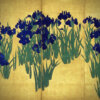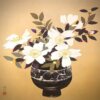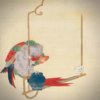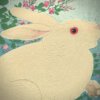Hasegawa Gyokuhō and Gyokujun: A Parent and Son Who Had Excellent Painting Techniques and Played Actively in Kyoto
Contents
“Akikusa Shōkin” (A Small Bird with Flowers and Leaves) by Hasegawa Gyokuhō
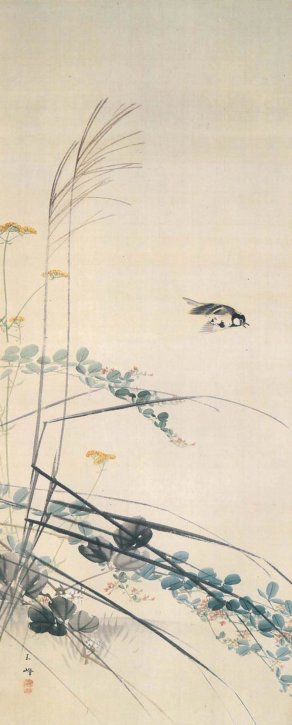
Hasegawa Gyokuhō who studied the painting technique under Matsumura Keibun belonged to Shijō school, was one of the best players of bird-and-flower painting and portraits. That should be the reason why, he drew many bird-and-flower paintings that make full use of the technique of “Tsuketate” (One of the typical techniques of Japanese painting that does not draw the outlines but do with one brushwork containing light and shade, two types of Sumi inks or paints simultaneously at once so that the result can express the shade and the stereoscopic effect, which can be often seen in Maruyama and Shijō schools). Gyokuhō was born in Kyoto in 1822. His painting style was similar to that of Keibun whom he studied under so that lots of the works were drawn with simple and straightforward brushstrokes besides the brilliance. In his later years, he enjoyed most of the time of his life in Ōtsu, which might be related to the fact he left lots of his pieces of works in Ōtsu, Shiga prefecture. The disciples of Gyokuhō were represented by Morikawa Sobun and Hasegawa Gyokujun who was the eldest son of Gyokuhō. Although so many pictures of flowers and birds, portraits and scenic spots Gyokuhō drew have been left, some parts of his trajectory have been still unclear. Anyway, he had two sons, the elder one is Hasegawa Gyokujun and the second is Hasegawa Gyokusui. The two sons studied under their father and forged their livelihoods by drawing Japanese paintings. Although the eldest son, Gyokujun once got renowned in the painting world of Kyoto, the second son, Gyokusui spent his whole life in obscurity. Gyokuhō ended up his life in 1879.
This picture, “Akikusa Shōkin” (A Small Bird with Flowers and Leaves in Winter) was drawn faithfully following to the painting style of his master, Matsumura Keibun, which expresses flowers and leaves in autumn. Japanese pampas grass, bush clover, patrinia scabiosaefolia, kudzu and other typical autumn leaves are trippingly drawn by the technique of Tsuketate. Many disciples who studied under Keibun drew pictures of autumn flowers same as this composition, which was probably because Keibun had a picture model for a small bird with flowers and leaves in autumn or insects with flowers and leaves in autumn. This picture of flowers and leaves in autumn was what painters belonged to Shijō school were good at with the profound lyricism. It was not the painting style just following to the sketch but harmonized the combination between bush clover and kudzu that spread horizontally, and Japanese pampas grass and patrinia scabiosaefolia that grow vertically. In addition, he drew a small bird which can fly onto the space. This is the typical and familiar way Keibun’s clan took for the flower and bird painting including Gyokuhō. The coloring is also modest, which can realize the clear autumn taste. Gyokuhō was one of the painters who followed the painting style of their master, Keibun faithfully. However, this picture looks additional taste by the unique painting style on his own, which expresses a part of natural scenes in autumn as well as the major parts were followed to his master, Keibun.
“Ōka Kōyō Kachō (Cherry Blossom with a Small Bird & Autumn Color of Leaves with a Small Bird) by Hasegawa Gyokujun

Hasegawa Gyokujun was born in Kyoto in 1863 as the eldest son of Hasegawa Gyokuhō who was a painter belonged to Shijō school and good at flower and bird painting. He studied the painting under his father, Gyokuhō, and became active in the painting world of Kyoto despite he was so young. In 1891, when establishing the “Young Painters Social Club”, he became a member of the club together with Takeuchi Seihō, Miyake Gogyō, and Taniguchi Kōkyō. Also, when holding “Dai Nippon Shiritsu Kaiga (Great Japan Private Paintings) Kyōshinkai Exhibition” in June of the same year, he was selected as a judge together with Kikuchi Hōbun, Takeuchi Seihō and Yamamoto Shunkyo. He was expected to be a promising painter in the future. In 1902, Miyawaki Baisen-an (a long-established store of Japanese folding fan that has been keeping the business until today) in Kyoto ordered the 48 Great Painting Masters at that time including Takeuchi Seihō and Tanomura Chokunyū to draw ceiling paintings whose patterns were folding fans. Gyokujun was the selected one and left his works there among them. However, he disappeared from the painting world of Kyoto and served as an art teacher at a higher primary school in Ōtsu around 1907. Although it has not been clear when Gyokujun came to Ōtsu, he seemed to spend considerable years in Ōtsu until he passed away at the age of 58 in 1921. Many works of his still remain in Ōtsu.
This picture was drawn by Gyokujun when he was around 40 years old, which was just the timing when he moved to Ōtsu. The representative flowers and trees of spring and autumn are drawn in 2-counter-screen, which is thought to be owed to the painting style he learned from his father, Gyokuhō. He depicted the double cherry blossoms and the tree in the figure of the cherry blossom and put dandelions in the underneath bush, and then, added a yellow bird flying from the tree to the bush. It just expresses the taste at spring in full bloom. In the figure of the autumn color, he depicted the beautifully handsome-foliage of the maple, which is colorfully changing the colors in front of the giant shaft. Also, a coal tit is playing on the branch. Dayflowers are appearing from the underneath bush. Eventually, the dayflowers are dying down and the maple which has been dyed red with autumn leaves would drop the more colored leaves along arrival of the cold wintry wind. Then, the tree would look playing like longing for the short sunlight and shivers actually due to the cold north wind in winter. This picture expresses the deepening and fugacious as well as beautiful taste in short autumn until then. The both pieces of works must be masterpieces in which Gyokujun created incorporating a new painting style during the radically changed Meiji era while basing on the sketching way of Shijō school, which makes us feel his unique mood of the painting.
Differences in Pictures of Peacock Looking from Two Generations Between the Parent and His Son
“Rōshō Kujakuzu” (Peacocks on an old pine and ground) by Hasegawa Gyokuhō
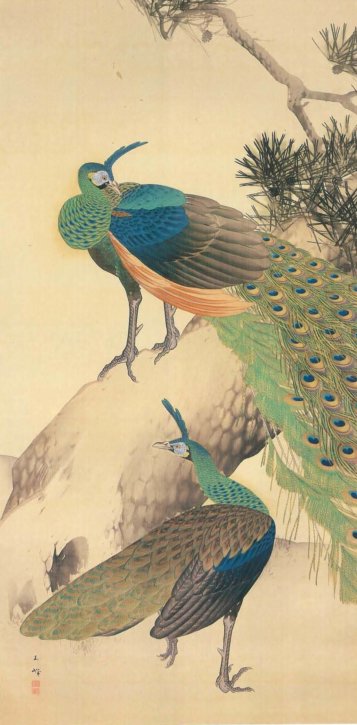
Gyokuhō was a town painter and belonged to Shijō school. He passed away at the age of 50 in 1888. Although he got through to live in the turbulent era from the end of the Edo period to the Meiji Restoration, his painting style does not look any influences of the new era but faithfully followed the painting style of Matsumura Keibun. When his eldest son, Gyokujun was active from the 20s to 30s of the Meiji era (around 1890s to 1900s), the wave of modernization stimulated young painters. The trail of Gyokujun’s struggle can be seen in the Kujakuzu (figure of peacock) Gyokujun drew, on the way to the modernization of Japanese painting when comparing the picture with the same titled one drawn by Gyokuhō.
Regardless of either Maruyama school, Shijō school or the others, so many painters drew the Kujakuzu that was one of the representative Japanese flower and bird paintings arranged with flowers including peonies and roses. “Botan Kujakuzu” (A peacock with peonies) drawn by Maruyama Ōkyo has been the most famous one. It was drawn brilliantly with rich colors such as patina, ultramarine blue and gold paint, which may bring about a kind of tense atmosphere and oppressiveness. While male and female peacocks in “Rōshō Kujakuzu” (Peacocks on an old pine and ground) drawn by Gyokuhō was done brilliantly with deep colors, the giant shaft of the old pine is colored with light Sumi ink and drawn lively in a relaxed manner. The male peacock firmly perches on the old pine which is arranged like laying down to the ground and the female peacock on the ground is walking while bracing. It is quite a masterpiece in Gyokuhō’s works. Usually, tail of male peacock should be drawn completely in a canvas because the tail feathers are ocellated so as to be extremely beautiful. However, it is not drawn completely but done on the halfway. The same goes for the giant shaft of the old pine. It is also drawn on the halfway. The way may express the endless expansion to the outside. Although the screen composition was commonly used in pictures on room partitions from the Momoyama period to the Edo period, the composition in this picture looks much more bold as Gyokuhō who was patronized by the emerging townspeople in the latter half of the Edo period. While the composition is magnificent, it also shows a light taste in the painting way to depict the giant shaft and branches, and the brushstroke to do the peacocks. As far as watching this picture, Gyokuhō should have been more remarked painter in Shijō school.
“Kujakuzu” (Peacocks on a Rock and Ground): Hasegawa Gyokujun
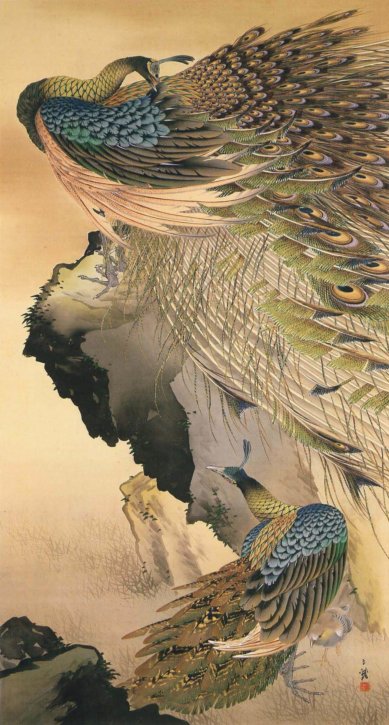
On the other hand, the same titled “Kujakuzu” drawn by Hasegawa Gyokuhō is thought to be produced in the last years of the Meiji era judging from the seal. It depicts a male peacock which grooms his plumes on a rock and a female peacock which stands on the ground under the rock and watches over the male peacock’s gestures while protecting a chick. Although it was common to draw a male peacock on a rock and a female peacock underneath the rock as a pair in one composition, the male figure in this picture was drawn with a drastic style. Usually, the most cases present the graceful appearance of male peacock in the titled pictures. However, the male eyes look too sharp and wild despite he is grooming his plumes in fact. Comparing to the chick’s figure that looks mellow and lovely, the depiction of the female also looks moving, which may be guessed that the female figure was drawn by catching a moment of her tremble. It is not a depiction of the sketched peacocks whose manner was handed down to the Shijō school, but looks the impression of Gyokujun’s consideration to seek for new expressions based on the sketches.
When comparing the same titled pictures for the same object between the parent and its son, we can feel some differences there, which can be said that something very interested matters may be there.


